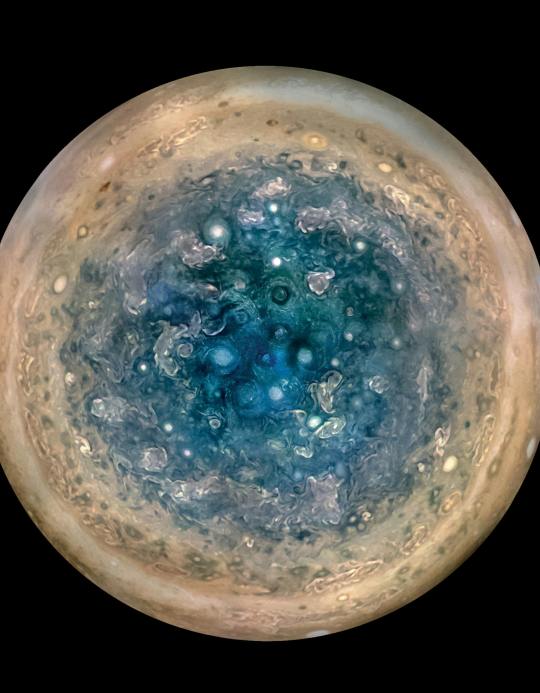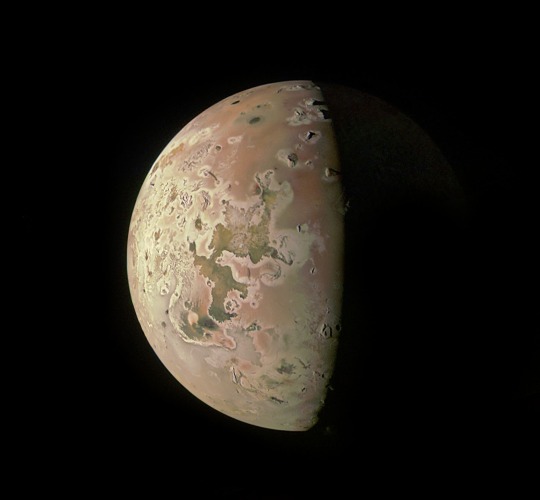#JunoCam
Explore tagged Tumblr posts
Text

jupiter south pole ~ nasa goddard space flight center | photo x betsy asher hall + gervasio robles
#circle#eye#photography#exploration#nature#astrophysics#solar system#jupiter#juno mission#space#junocam#polar cyclones
211 notes
·
View notes
Text

JUPITER | PJ68 Jet N6
2024-12-27 04:56 UT Mission Phase : PERIJOVE 68 | Product ID: JNCE_2024362_68C00033_V01 See more -> https://www.missionjuno.swri.edu/junocam/processing?source=public&featured=1&ob_from=&ob_to=&perpage=16
Credit : NASA / SwRI / MSSS / Jackie Branc © CC BY
12 notes
·
View notes
Text

Closest photo of lo by the Juno cam!
Such a clear detailed photograph
#spaceporn#james webb space technology#junoverse#junocam#jupiter#nasawebb#nasa#nasa photos#nasa picture of the day#nasa breaking news#astro community#astro observations#astronomers#astrophotography#astronomy
121 notes
·
View notes
Text
youtube
JunoCam!
Launched in 2006, this year (2024) marks its mission end. I love that they stuck another camera on the thing just to take pretty pictures. No direct science benefit anticipated. Basically a PR stunt.
AND YET when artists got ahold of the raw image data they transformed it in ways that helped the scientific community make breakthroughs nobody anticipated.
10 notes
·
View notes
Text
Stunning New Photos of Jupiter from Juno's Recent Flyby
The biggest planet in our solar system by far, Jupiter is still very much unexplored, with so much more to learn about its swirling storms, and highly active gaseous surface. A recent flyby from NASA’s Juno spacecraft shows us more details of the planet, its 66th trip around the celestial body. While Juno’s onboard cameras can take images, NASA does not have a dedicated team to process these for…
0 notes
Text

Rebuilding some old stuff from junocam.
The Juno spacecraft has one optical camera (its weird), all this camera does is dump images online for people to parse.
the problem is that they just dump it.

Back in like 2020 I parsed this by hand using paint and it took a while™. Now I have tools that I can use on this data and I can build scripts to parse it all. There's still a lot that needs to be worked on, but the progress is running nicely. Currently all the bands are seperate and in their own files. I just need to combine all the channels back into one image (I did it by hand up top). Some of the combining has caused some weird distortions (jupiter is not a sphere anmore so I'll probably need to do a lot of transformations), but it's late and thats for tomorrow.
Also looking at those photos I'm seeing something. gotta start collecting and processing
0 notes
Text
Pluma de Io capturada por Juno Cam
La nave espacial Juno de la NASA capturó una imagen impresionante de la pluma de Io, la luna más volcánicamente activa del Sistema Solar. La imagen, tomada el 15 de octubre de 2023, muestra la pluma elevándose desde el volcán Pillan Patera en la superficie de Io. La pluma es de color rojo brillante y se extiende hasta una altura de varios cientos de kilómetros. Está compuesta de una variedad de…

View On WordPress
#Ciencias y Tecnologías#io#Júpiter#JPL-Caltech#Juno#JunoCam#NASA#Nave espacial#Nuevos#Planetas enanos
0 notes
Text
This highly stylized view of Jupiter's icy moon Europa is based on an image captured by JunoCam, the public engagement camera aboard NASA's Juno spacecraft, during the mission's close flyby on Sept. 29, 2022. Citizen scientist Fernando Garcia Navarro created the image by processing a JunoCam previously worked on by fellow citizen scientist Kevin M. Gill. Navarro calls his rendering "Fall Colors of Europa."
#AmateurAstronomy#ScienceRules#SomewhereDeepInTheNight#KeepLookingUp#BackyardAstronomy#JunoCam#Citizen Science#Jupiter Juno Mission#NASA Juno#Moons of Jupiter#Europa Jupiter
0 notes
Text
A recent image of Jupiter captured by Juno spacecraft.
Process on an image processed by Gerald - Enhancement of colors
NASA / JPL / SwRI / MSSS / Gerald Eichstädt / Thomas Thomopoulos
More: missionjuno.swri.edu/junocam/proces…

#nasa#nasa photos#nasa jpl#jpl#SwRI#msss#Gerald Eichstädt#Thomas Thomopoulos#Process on an image processed by Gerald - Enhancement of colors#More: missionjuno.swri.edu/junocam/proces…#jupiter#captured by Juno spacecraft#cosmos#Unknown cosmos and unexplored space#de tot#xpuigc#xpuigc bloc
18 notes
·
View notes
Photo

2025 April 19
Painting with Jupiter Image Credit: NASA, JPL-Caltech, SwRI, MSSS; Processing: Rick Lundh
Explanation: In digital brush strokes, Jupiter's signature atmospheric bands and vortices were used to form this interplanetary post-impressionist work of art. The creative image from citizen scientist Rick Lundh uses data from the Juno spacecraft's JunoCam. To paint on the digital canvas, a JunoCam image with contrasting light and dark tones was chosen for processing and an oil-painting software filter applied. The image data was captured during perijove 10. That was Juno's December 16, 2017 close encounter with the solar system's ruling gas giant. At the time the spacecraft was cruising about 13,000 kilometers above northern Jovian cloud tops. Now in an extended mission, Juno has explored Jupiter and its moons since entering orbit around Jupiter in July of 2016.
∞ Source: apod.nasa.gov/apod/ap250419.html
87 notes
·
View notes
Text

JUPITER | PJ66 Jet N6 | 2024-10-22 17:40 UT
Mission Phase : PERIJOVE 66
Credit : NASA / SwRI / MSSS / Jackie Branc © CC BY
Full project -> https://jackiebranc.site/jupiter-and-its-galilean-moons/
#Jupiter#gas giant#photographers on tumblr#elloon#Juno#Juno Mission#JunoCam#citizen science#SwRI#MSSS#Jackie Branc#solar system
10 notes
·
View notes
Text
Jupiter's moon, Io, is the most volcanic body in the Solar System. NASA's Juno spacecraft has been getting closer and closer to Io in the last couple of years, giving us our first close-up images of the moon in 25 years. Recent JunoCam images show a new volcano that appeared sometime after the Galileo spacecraft visited the region. The new volcano is just south of Io's equator. Since tidal heating from Jupiter causes Io's volcanic activity, most volcanoes are in the moon's equatorial region, within about 30 degrees north and south of the equator.
Continue Reading.
68 notes
·
View notes
Text

A JunoCam View of Europa
107 notes
·
View notes
Text

babe wake up new junocam images of Io just dropped. look at all that tidal volcanism. let's go for a swim in some Jovian moon lava pools.
198 notes
·
View notes
Photo

This image shows Jupiter’s south pole, as seen by NASA’s Juno spacecraft from an altitude of 32,000 miles (52,000 kilometers). The oval features are cyclones, up to 600 miles (1,000 kilometers) in diameter. Multiple images taken with the JunoCam instrument on three separate orbits were combined to show all areas in daylight, enhanced color, and stereographic projection.
Image Credit: NASA/JPL-Caltech/SwRI/MSSS/Betsy Asher Hall/Gervasio Robles
13 notes
·
View notes

